| Topic: DRAGONS UNICORNS MERMAIDS PEGASUS OTHER MYTHIC ANIMALS | |
|---|---|
    Never want to come across one of those, however the ships are pretty cool Never want to come across one of those, however the ships are pretty cool
it disappeared |
|
|
|
|
     
|
|
|
|
|
|
Try tomorrow. My head is pounding need more rest good night.
   
           
|
|
|
|
|
|
What a coincidence I have pounding headache going to bed early sweet dreams.
         
|
|
|
|
|
|
What a coincidence I have pounding headache going to bed early sweet dreams.          
That is why I laid down earlier in the day. Hope your headache has moved on. What a pain in the head. 
|
|
|
|
|
|
Edited by
tazzops
on
Tue 07/19/11 05:19 AM
|
|

Kraken are legendary sea monsters of gargantuan size, said to have dwelt off the coasts of Norway and Iceland. The sheer size and fearsome appearance attributed to the beasts have made them common ocean-dwelling monsters in various fictional works (see Kraken in popular culture). The legend may actually have originated from sightings of real giant squid that are variously estimated to grow to 13–15 m (40–50 ft) in length, including the tentacles. These creatures normally live at great depths, but have been sighted at the surface and have reportedly attacked ships. In modern German, Krake (plural and declined singular: Kraken) means octopus but can also refer to the legendary Kraken.[5] In Norwegian, Kraken is the definite form of krake, a word that can refer to the legendary monster, but also means "frail, poor being", or "crooked, withered tree".[6] Even though the name kraken never appears in the Norse sagas, there are similar sea monsters, the hafgufa and lyngbakr, both described in Örvar-Odds saga as giant sea monsters that fed on whales, ships, men, and anything they could find. The Norwegian text from c. 1250, Konungs skuggsjá.[8] Carolus Linnaeus included kraken as cephalopods with the scientific name Microcosmus in the first edition of his Systema Naturae (1735), a taxonomic classification of living organisms, but excluded the animal in later editions. Kraken were also extensively described by Erik Pontoppidan, bishop of Bergen, in his "Natural History of Norway" (Copenhagen, 1752–3). Early accounts, including Pontoppidan's, describe the kraken as an animal "the size of a floating island" whose real danger for sailors was not the creature itself, but the whirlpool it created after quickly descending back into the ocean. However, Pontoppidan also described the destructive potential of the giant beast: "It is said that if it grabbed the largest warship, it could manage to pull it down to the bottom of the ocean" (Sjögren, 1980). Kraken were always distinct from sea serpents, also common in Scandinavian lore (Jörmungandr for instance). A representative early description is given by the Swede Jacob Wallenberg in his book Min son på galejan ("My son on the galley") from 1781: ... Kraken, also called the Crab-fish, which [according to the pilots of Norway] is not that huge, for heads and tails counted, he is no larger than our Öland is wide [i.e., less than 16 km] ... He stays at the sea floor, constantly surrounded by innumerable small fishes, who serve as his food and are fed by him in return: for his meal, if I remember correctly what E. Pontoppidan writes, lasts no longer than three months, and another three are then needed to digest it. His excrements nurture in the following an army of lesser fish, and for this reason, fishermen plumb after his resting place ... Gradually, Kraken ascends to the surface, and when he is at ten to twelve fathoms, the boats had better move out of his vicinity, as he will shortly thereafter burst up, like a floating island, spurting water from his dreadful nostrils and making ring waves around him, which can reach many miles. Could one doubt that this is the Leviathan of Job? According to Pontoppidan, Norwegian fishermen often took the risk of trying to fish over kraken, since the catch was so good. If a fisherman had an unusually good catch, they used to say to each other, "You must have fished on Kraken." Pontoppidan also claimed that the monster was sometimes mistaken for an island, and that some maps that included islands that were only sometimes visible were actually indicating kraken. Pontoppidan also proposed that a young specimen of the monster once died and was washed ashore at Alstahaug (Bengt Sjögren, 1980). Imaginary view of a gigantic octopus seizing a ship. Since the late 18th century, kraken have been depicted in a number of ways, primarily as large octopus-like creatures, and it has often been alleged that Pontoppidan's kraken might have been based on sailors' observations of the giant squid. In the earliest descriptions, however, the creatures were more crab- like than octopus-like, and generally possessed traits that are associated with large whales rather than with giant squid. Some traits of kraken resemble undersea volcanic activity occurring in the Iceland region, including bubbles of water; sudden, dangerous currents; and appearance of new islets. In 1802, the French malacologist Pierre Dénys de Montfort recognized the existence of two kinds of giant octopus in Histoire Naturelle Générale et Particulière des Mollusques, an encyclopedic description of mollusks. Montfort claimed that the first type, the kraken octopus, had been described by Norwegian sailors and American whalers, as well as ancient writers such as Pliny the Elder. The much larger second type, the colossal octopus (depicted in the above image), was reported to have attacked a sailing vessel from Saint-Malo, off the coast of Angola. Montfort later dared more sensational claims. He proposed that ten British warships that had mysteriously disappeared one night in 1782 must have been attacked and sunk by giant octopuses. Unfortunately for Montfort, the British knew what had happened to the ships, resulting in a disgraceful revelation for Montfort. Pierre Dénys de Montfort's career never recovered and he died starving and poor in Paris around 1820 (Sjögren, 1980). In defence of Pierre Dénys de Montfort, it may be noted that some of his sources for the "kraken octopus" may have described the very real giant squid, Architeuthis, proven to exist in 1857. The Kraken by Tennyson Below the thunders of the upper deep; Far far beneath in the abysmal sea, His ancient, dreamless, uninvaded sleep The Kraken sleepeth: faintest sunlights flee About his shadowy sides; above him swell Huge sponges of millennial growth and height; And far away into the sickly light, From many a wondrous grot and secret cell Unnumber'd and enormous polypi Winnow with giant arms the slumbering green. There hath he lain for ages, and will lie Battening upon huge seaworms in his sleep, Until the latter fire shall heat the deep; Then once by man and angels to be seen, In roaring he shall rise and on the surface die. In 1830, Alfred Tennyson published his popular poem "The Kraken" (essentially an irregular sonnet). The poem in its last three lines, also bears similarities to the legend of Leviathan, a sea monster, who legend tells shall rise to the surface at the end of days. Pontoppidan's description influenced Jules Verne's depiction of the famous giant squid in Twenty Thousand Leagues Under the Sea from 1870. Later developments of the Kraken image may be traced at Kraken in popular culture. |
|
|
|
|
|
Edited by
tazzops
on
Tue 07/19/11 09:26 AM
|
|

An Abominable Snowman is generally described as being human-like but larger, covered with white shaggy fur and as having huge feet. It is also referred to as a Yeti. Though one has never been photographed or filmed, footsteps have been found and measured. These legendary huge furry beasts reside at the top of the highest mountains in the world, the Himalayans. Several monasteries in Tibet claim they possess remains that are that of an actual Yeti. Local tribes regard these mountain dwellers, the Mehteh with great respect. They will turn around anytime they encounter a large footprint. Though these beasts are supposed to be extremely territorial, they are known to mostly eat greens and vegetables. They will however, enjoy feasting on human flesh if the opportunity presents itself. There have been many reports in the 20th century involving footprints and possible sightings of these elusive mountain dwelling beasts. Who or what is responsible for leaving these large footprints on the snow covered Himalayans? Will we ever know? Even to this day, similar incidents keep making headline news. |
|
|
|
|
|
Edited by
tazzops
on
Tue 07/19/11 09:30 AM
|
|

The Aswang is a vampire-like witch that is also capable of shape-shifting. A common description of the Asuwang is of a witch with leathery wings and sharp fangs. It is also described appearing as a bat, dog or snake. This creature would stalk its victims at night, creepily walking with its feet facing backwards. These predatory mythical creatures are also known to rob graves and eat the dead bodies they find within. They then replace the corpses with a banana tree carving that resembles the deceased they just consumed. Some believe that these monsters assume regular human bodies and carrying on amongst the living during the day but turn into their blood-thirsty monstrous state at night. It is said that having a bowl of coconut oil could warn against the presence of these deadly creatures. The oil would start to heat up and boil the closer one of these monsters would approach. Throwing salt would burn their skin and a pouch filled with ginger and coins would help keep them away. |
|
|
|
|
|
Edited by
tazzops
on
Tue 07/19/11 09:33 AM
|
|
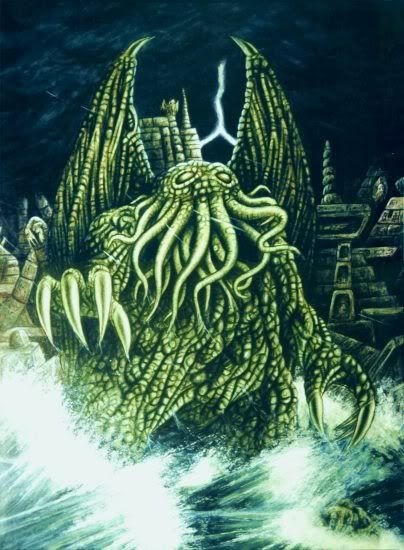
The Cthulhu had thick green skin that was covered with scales and riddled with wart-like bumps. His squid-like head had long thick tentacles surrounding it. These could easily crush any human that tried to oppose or attack it. Giant bat-like wings folded out of its back and its feet were sharp, eagle-like talons. It could use these to take hold of enemies from the air and shred them apart. This sea monster was the high priest of an ancient race of aliens referred to as “The Great Old Ones”. This blood thirsty mythical beast had the power to invade people’s dreams and control them with its mind. The story goes that once every age, the underwater city of R’lyeh surfaces and with it this monstrous high priest. Once on the surface, this evil creature takes control of all the weak minded people that it can. He then causes them to perform human sacrifices to prove their loyalty to him. Each time the city of R’lyeh surfaces this horrible green monster goes on a rampage of death and destruction to quench his thirst for bloodshed and violence. |
|
|
|
|
|
Edited by
tazzops
on
Tue 07/19/11 09:37 AM
|
|

Fenrir was the son of the very devious Norse god named Loki. This canine's father, who continuously battled with the other Norse gods, had great plans for this enormous wolf and his brother Jormungand - to someday ravage and destroy all humans on earth. Fearing Loki's intentions, the other Norse gods separated the wolf from his father when he was still just a pup. He very quickly grew to a gigantic size, so the gods unanimously agreed to chain him up and keep him locked up until the end of time. The gods became, which must have been slightly bored and over confident in the control over the seemingly stupid beast, that they one day, challenged him to break free. To their complete dismay, it did so with such ease that is made the chains that bound it seem but like simple paper. The gods then had to enlist the help of some dwarves to create a magical ribbon called Glepnir. Once the oversized wolf was bound with this enchanted ribbon, it absolutely could no longer break free. |
|
|
|
|
|
Edited by
tazzops
on
Tue 07/19/11 09:46 AM
|
|
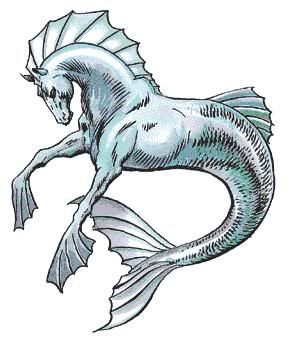
The Kelpie often appears with its mane dripping with water, standing near a freshwater stream, river or lake. It resembles a beautiful pony with either a white or grayish black coat. It can be identified by pieces of seaweed caught and tangled in its long, dripping wet mane. Passersby would come across this seemingly tame pony and quickly be lured and tempted to mount it. The riders would then find themselves magically stuck to its back. Once mounted, the deadly pony would dive into the deepest waters and drown the unfortunate passengers. It was also capable of shape-shifting and assuming a human form to seduce a human lover. Its shape-shifting powers are said to be contained in its magical bridle. If captured, this deadly water pony was said to have the strength of up to ten regular horses. This mythical horse was also known to warn against upcoming storms by wailing and howling. 
|
|
|
|
|
|
Edited by
tazzops
on
Tue 07/19/11 10:02 AM
|
|
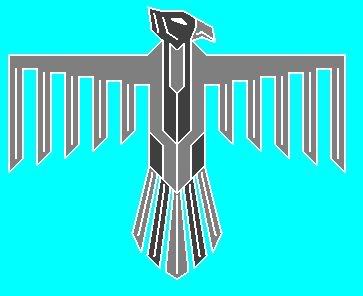
The Thunderbird was an enormous supernatural bird of tremendous strength and power, capable of causing storm like winds and thunder by simply beating its wings. This creature was said to be able to shoot lightening from its' eyes and fill the sky with the darkest clouds as it flew overhead. It resembled an oversized eagle with either one or two heads and sometimes described as having rows of teeth inside its' huge menacing beak. This was one creature that many agreed was best to avoid and at all costs, refrain from disturbing or upsetting in anyway. Some North American indigenous tribes believed that these formidable mythical creatures could shape shift into human form and take on human mates. The families created would then keep to themselves while living the day to day in human form but, if the need arose, they could simply put on their supernatural feather blankets to tranform and take vengeance on anyone or anything that threatened their existence. 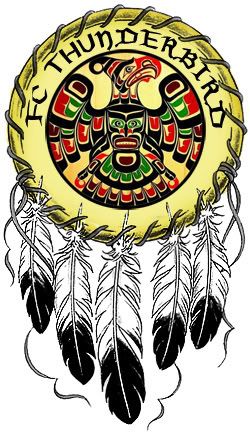
|
|
|
|
|
|
Edited by
tazzops
on
Tue 07/19/11 10:06 AM
|
|
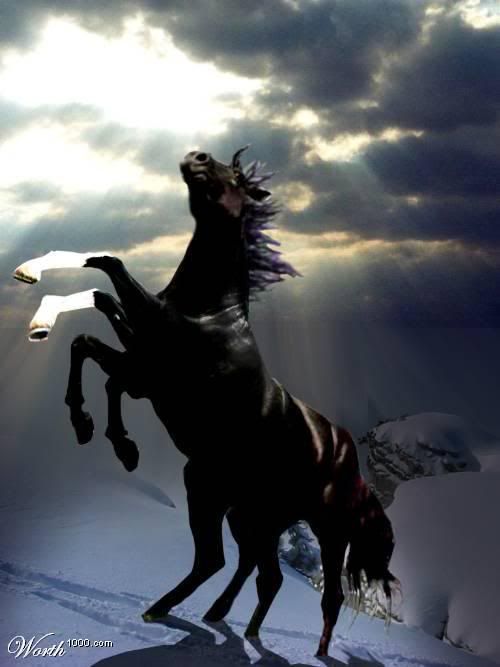
Sleipnir was the fastest, largest and most powerful horse in the world. He was enchanted, extremely strong and capable of incredible speeds on land, sea and air. This magnificent horse had magical symbols carved into his teeth which were said to be the source of his powers. Odin, the King of the Norse gods controlled this splendid beast as his personal steed and rode him whenever he travelled between earth and the city of Asgard, keeping a watchful eye on all that was unfolding. Odin, with this mighty and skillful horse, also kept occupied riding around in search of the bodies of fallen Viking warriors to deliver them to their final resting place; the burial grounds of Valhalla. |
|
|
|
|
|
Edited by
tazzops
on
Tue 07/19/11 10:09 AM
|
|
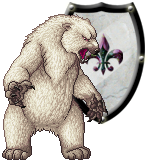
The Nandi Bears are very large, muscular beasts with long sharp claws and spotted fur. They have very similar physical features to the well known hyena but are much larger, angrier and only have a single eye in the middle of their foreheads. They are also quite agile at climbing trees to spy and then ambush their helpless victims. These mythical beasts are extremely violent and following every vicious attack, it is said that they feast on the brains of their victims with immeasureable pleasure. Victims were often found with their skulls completely crushed and their brains missing. Once their single, evil eye had you in its sight, there was little to no chance of escaping. Over the past decades, there have been several reported encounters and sightings of this despicable monster. Scientists have even speculated that these bears could actually be a subspecies of hyenas thought to be extinct or one that has not been yet identified. 
|
|
|
|
|
|
Edited by
tazzops
on
Tue 07/19/11 10:16 AM
|
|
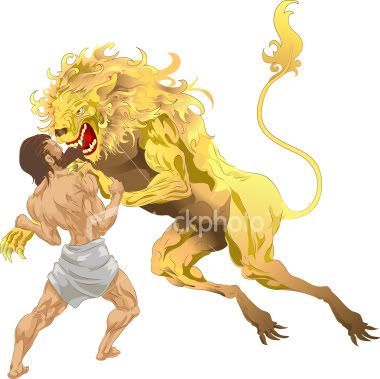
The Nemean Lion was gifted with supernatural mystic powers and was virtually undefeatable. With all the same features of a normal lion, amplified strength, along with impenetrable skin - this vicious beast seemed unstoppable. Not a single man made weapon could damage or cut through this formidable mythical beast's hide. It terrorized and killed many people near and around the ancient city of Nemea with, what seemed to be a ravenous taste for blood. Selene, the moon goddess adored this beast greatly. In some accounts, Selene and Zeus are said to have been the actual proud parents of this indestructible feline. Hercules was commanded by King Eurystheus to kill the lion, which he succeeded in doing by using his super human strength. He entered its den, and somehow during battle managed to wrap his arms around the lion's neck and use his astounding power to strangle the last breath out of the feline. He then skinned the beast with one of its own razor sharp claws and made a cloak with its pelt to wear as armor. |
|
|
|
|
|
Edited by
tazzops
on
Tue 07/19/11 10:26 AM
|
|

Amphisbaena was born from the blood that dripped from Medusa’s severed head as Perseus flew and carried it over the Libyan Desert. In the beginning it was described as being a deadly poisonous, two headed snakelike creature. In later drawings it is shown as having scaled chicken-like feet and feathered wings. Some pictures even show it as being more dragon-like with horns and small round ears. Both heads were identical – making it impossible to know which end was charging. In ancient times, expecting women wearing one of these creepy snakes live around their necks would assure themselves a safe pregnancy. If the meat of this serpent was ingested, one couldattract many lovers of the opposite sex. Killing one during a full moon would give power to the pure of mind and heart. If only the skin was worn around ones neck – it could even cure the common cold. 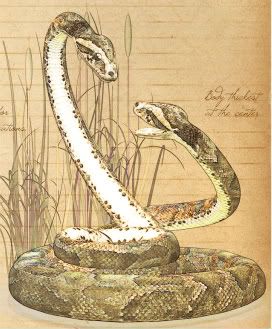
|
|
|
|
|
    What unique creatures, I like the thunderbird What unique creatures, I like the thunderbird
|
|
|
|
|
|
Kind of like the Snowman. I could sit with him around a camp fire.
|
|
|
|
|
 It does look like he is sitting in front of the campfire, warmining his hands, I like the wolf creature, but I think the wolves nowadays are so much prettier. It does look like he is sitting in front of the campfire, warmining his hands, I like the wolf creature, but I think the wolves nowadays are so much prettier.
|
|
|
|
|
|
It sure does look like he is sitting in front of a fire warming his hands. I remember reading in high school of the Fenrir in Norse mythology.
|
|
|
|
|







